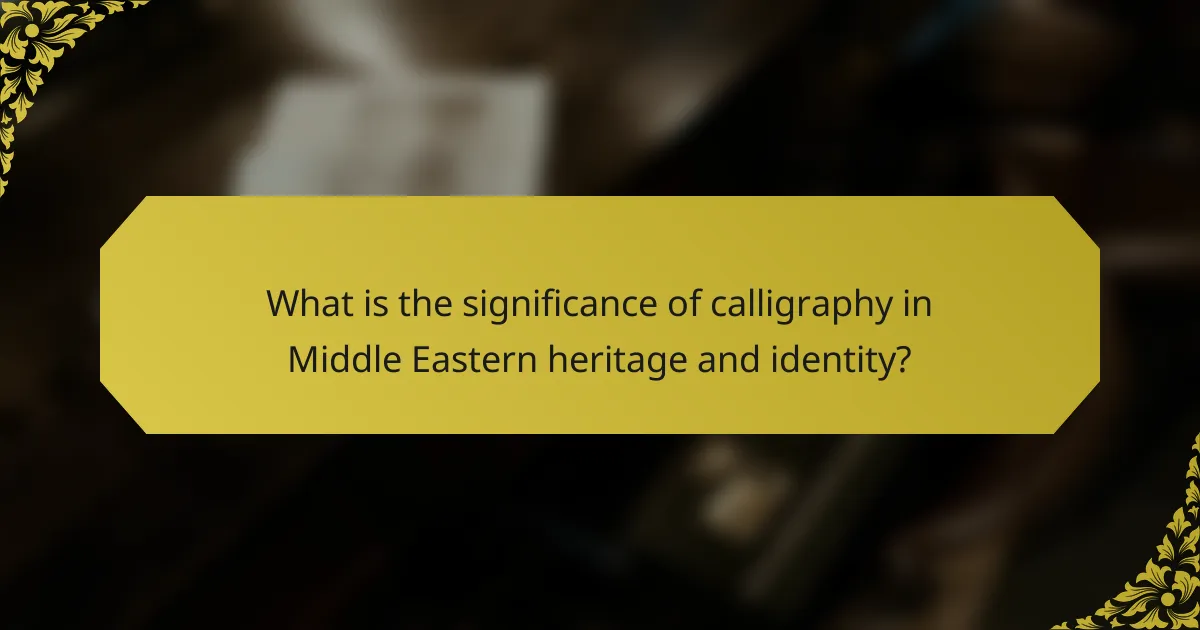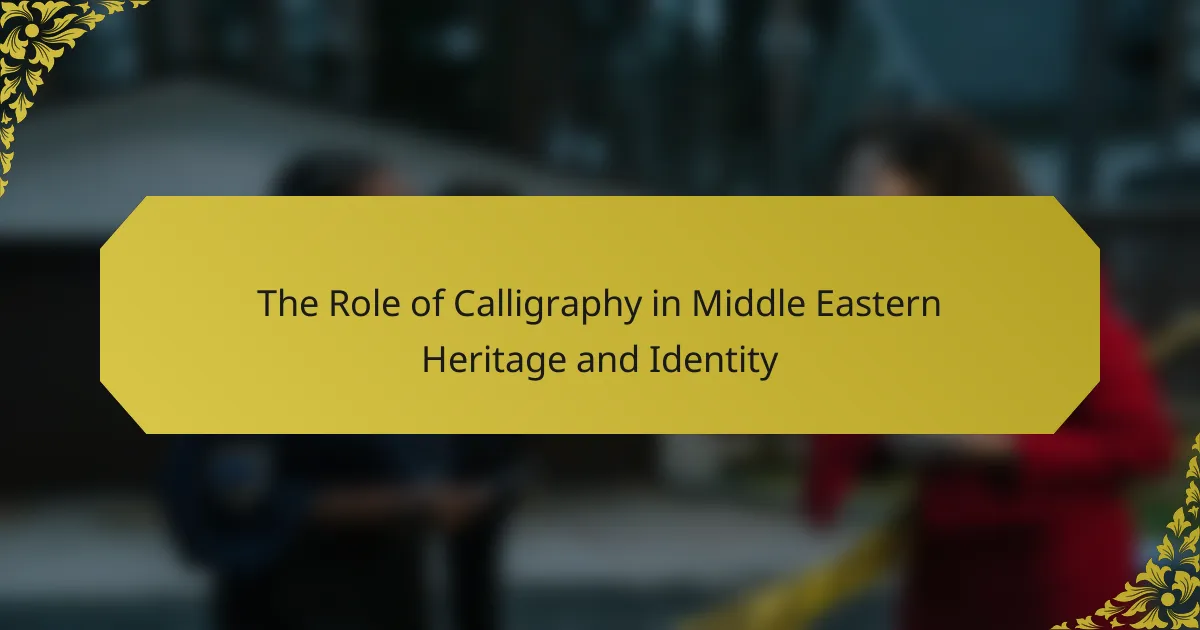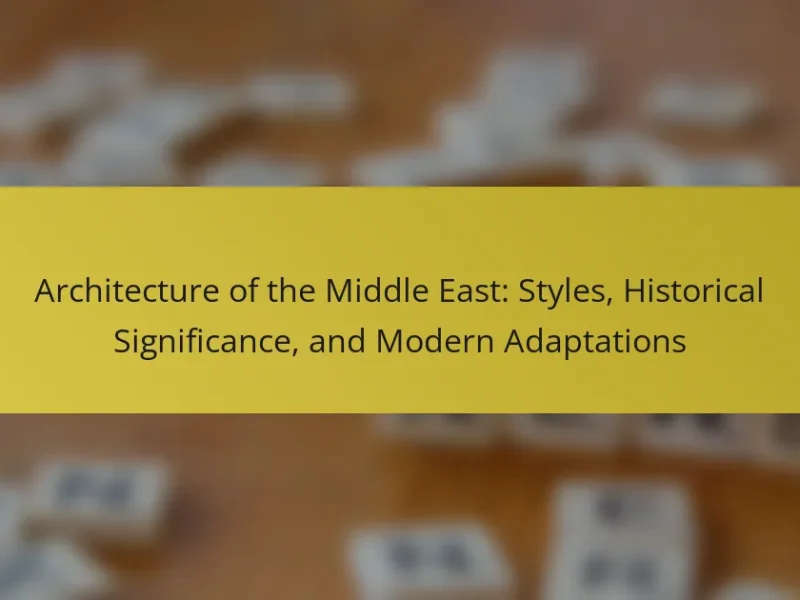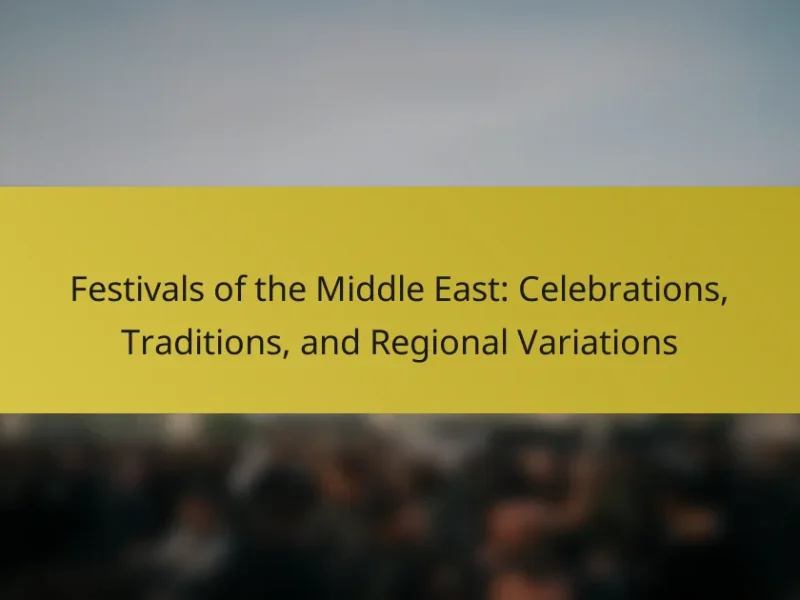
What is the significance of calligraphy in Middle Eastern heritage and identity?
Calligraphy holds significant cultural and artistic value in Middle Eastern heritage and identity. It is a revered form of artistic expression that reflects the region’s history and [censured]. Calligraphy is often used to convey religious texts and poetry, highlighting its importance in Islamic culture. The intricate designs and styles of calligraphy illustrate the region’s artistic diversity. Historical manuscripts and architectural inscriptions showcase the evolution of calligraphic art over centuries. Calligraphy serves as a symbol of national pride and cultural identity for many Middle Eastern communities. It connects people to their ancestry and traditions, reinforcing a shared cultural narrative. Through education and preservation efforts, calligraphy continues to be celebrated and practiced today.
How has calligraphy evolved throughout Middle Eastern history?
Calligraphy has evolved significantly throughout Middle Eastern history. Initially, it began as a practical means of communication in ancient scripts. Over time, it transformed into an art form, particularly during the Islamic Golden Age. The introduction of the Arabic script in the 7th century influenced its development. Calligraphers began to experiment with various styles, such as Kufic and Naskh. Each style reflected cultural and religious significance. The Ottoman Empire further advanced calligraphy, promoting it as a prestigious art. Today, calligraphy remains a vital aspect of Middle Eastern identity and heritage, symbolizing artistic expression and cultural continuity.
What are the historical influences on Middle Eastern calligraphy?
Middle Eastern calligraphy has been influenced by various historical factors. The spread of [censured] in the 7th century significantly shaped its development. Arabic script became the primary medium for religious texts. The Abbasid Caliphate (750-1258) promoted artistic expression, leading to the refinement of calligraphic styles. Persian and Ottoman cultures also contributed unique elements to calligraphy. The integration of geometric patterns and floral motifs emerged during the Safavid period. Additionally, the advent of printing in the 19th century impacted traditional calligraphy practices. These influences collectively highlight the evolution and significance of calligraphy in Middle Eastern heritage.
How did different cultures contribute to the art of calligraphy?
Different cultures significantly contributed to the art of calligraphy through unique styles and techniques. For instance, Islamic culture developed intricate scripts like Naskh and Thuluth, emphasizing beauty and [censured]. Chinese calligraphy introduced brush techniques that influenced fluidity and expression in lettering. Japanese calligraphy, or Shodō, integrated Zen principles, focusing on the meditative aspect of writing. Each culture brought distinct materials and tools, such as reed pens in the Middle East and brushes in East Asia. Historical texts, like the “Book of Calligraphy” by Wang Xizhi, showcase the evolution of styles across regions. Thus, the interplay of these diverse influences shaped calligraphy into a global art form.
What are the various styles of calligraphy found in the Middle East?
The various styles of calligraphy found in the Middle East include Arabic, Persian, Ottoman, and Diwani. Arabic calligraphy is known for its fluidity and artistic expression. Persian calligraphy often incorporates intricate designs and embellishments. Ottoman calligraphy developed under the Ottoman Empire, featuring a unique blend of styles. Diwani is characterized by its cursive and decorative nature, often used in official documents. Each style reflects cultural and historical significance in the region. Calligraphy serves as a vital aspect of Middle Eastern heritage and identity, showcasing artistic skill and religious devotion.
What are the distinguishing features of Arabic calligraphy?
Arabic calligraphy is characterized by its intricate designs and fluid forms. It employs a variety of scripts, including Naskh, Thuluth, and Diwani. Each script has unique structural characteristics. The use of geometric shapes and patterns is prominent in Arabic calligraphy. Calligraphers often incorporate decorative elements, such as floral motifs. The art form emphasizes balance and proportion in its compositions. Arabic calligraphy is not just textual; it conveys deep cultural and spiritual significance. Historically, it has been used in religious texts and architectural designs.
How do regional variations impact calligraphic styles?
Regional variations significantly impact calligraphic styles by influencing techniques, forms, and cultural meanings. Different regions develop unique scripts based on local traditions and historical contexts. For instance, the Naskh script is prevalent in the Arab world, while Persian calligraphy favors the Nasta’liq style. These variations arise from the integration of local artistic influences and the adaptation to different writing materials. Additionally, regional dialects and languages shape the use of specific calligraphic forms. Historical events, such as the spread of [censured], also contributed to the evolution of regional styles. The distinct characteristics of each style reflect the cultural identity and heritage of the communities that practice them.
Why is calligraphy considered a form of cultural expression?
Calligraphy is considered a form of cultural expression because it embodies the artistic representation of language and script. This art form reflects the historical and cultural identity of communities. In many cultures, particularly in the Middle East, calligraphy is deeply intertwined with religion and philosophy. It serves as a medium to convey spiritual messages and cultural narratives. The styles of calligraphy vary significantly across regions, showcasing unique cultural influences. For instance, Arabic calligraphy has evolved into various forms, like Diwani and Naskh, each with its own significance. The intricate designs and techniques used in calligraphy often represent the values and aesthetics of a society. Furthermore, calligraphy is celebrated in cultural events, reinforcing its role in preserving heritage. Overall, calligraphy is a vital means of expressing cultural identity and continuity.
How does calligraphy reflect the values and beliefs of Middle Eastern societies?
Calligraphy reflects the values and beliefs of Middle Eastern societies through its artistic expression and cultural significance. It embodies the reverence for language, particularly Arabic, which is considered sacred in [censured]. Calligraphy serves as a means of communicating spiritual and philosophical ideas. It often includes verses from the Quran, emphasizing the importance of faith. The intricate designs symbolize beauty and harmony, aligning with cultural aesthetics. Historically, calligraphy was a prestigious art form, showcasing the skill and education of the artist. It also represents identity and heritage, connecting communities to their historical roots. Overall, calligraphy is a vital expression of cultural values and beliefs in Middle Eastern societies.
In what ways does calligraphy serve as a medium for storytelling?
Calligraphy serves as a medium for storytelling by visually conveying narratives through artistic lettering. The intricate designs often reflect cultural tales and historical events. Each stroke and flourish can represent specific emotions or themes. Calligraphic texts can depict religious stories, poetry, or proverbs, enhancing their significance. The aesthetics of calligraphy draw viewers in, inviting them to explore the narrative deeper. Historically, manuscripts adorned with calligraphy have preserved and communicated oral traditions. This art form bridges generations, connecting past and present stories. In Middle Eastern culture, calligraphy is not just writing; it is an art that encapsulates identity and heritage.
How does calligraphy connect to religious practices in the Middle East?
Calligraphy is deeply connected to religious practices in the Middle East, particularly in [censured]. It is used to transcribe and beautify the Quran, which is the holy book of [censured]. This practice elevates the text’s spiritual significance and enhances its aesthetic appeal. Calligraphy serves as a means of expressing devotion and reverence to God.
Historically, Islamic calligraphy emerged as a prominent art form during the Umayyad and Abbasid caliphates. It became a way to convey religious messages and teachings visually. Many mosques and religious texts feature intricate calligraphic designs that reflect the beauty of the divine word.
Moreover, calligraphy is not limited to the Quran; it also adorns religious artifacts, architecture, and manuscripts. This integration of calligraphy into religious life fosters a sense of identity and continuity among Muslim communities. Overall, calligraphy plays a vital role in the religious and cultural landscape of the Middle East.
What role does calligraphy play in Islamic art and architecture?
Calligraphy serves as a fundamental element in Islamic art and architecture. It embodies the spiritual and cultural values of [censured]. Islamic calligraphy often features verses from the Quran. This practice reflects the importance of the written word in conveying religious messages. Calligraphy enhances the aesthetic appeal of mosques and other Islamic structures. It is commonly found on walls, domes, and minarets. The art form transcends mere decoration; it represents a form of worship and devotion. Historically, calligraphy has been seen as a way to connect with the divine.
How is calligraphy used in religious texts and manuscripts?
Calligraphy is used in religious texts and manuscripts to convey sacred messages with artistic precision. It enhances the readability and aesthetic value of the text. In Islamic culture, for instance, calligraphy is often employed to transcribe the Quran. This practice reflects the belief that the written word is divine. Historical manuscripts showcase intricate designs that elevate the spiritual experience. Additionally, calligraphy serves as a means of preserving cultural identity. Many religious texts are adorned with elaborate calligraphic styles unique to specific regions. This artistry connects communities to their heritage and faith.
What contemporary applications of calligraphy exist in Middle Eastern culture?
Contemporary applications of calligraphy in Middle Eastern culture include art, branding, and education. Calligraphy is often used in modern art installations, reflecting cultural identity. It appears in advertising to convey authenticity and tradition. Educational institutions incorporate calligraphy into curricula to preserve heritage. Social media platforms showcase calligraphy as a popular art form. Events like calligraphy competitions promote skills and interest among youth. Public spaces often feature calligraphic murals, enhancing community aesthetics. These applications demonstrate the relevance of calligraphy in contemporary cultural expressions.
How is calligraphy being integrated into modern design and branding?
Calligraphy is being integrated into modern design and branding through its unique visual appeal and cultural significance. Designers utilize calligraphic styles to create distinctive logos and brand identities. This integration enhances brand storytelling by connecting to heritage and tradition. Brands like Coca-Cola and Nike have incorporated calligraphy to evoke emotions and cultural resonance. Digital tools now allow for the adaptation of traditional calligraphy into contemporary formats. This fusion appeals to consumers seeking authenticity and craftsmanship. The resurgence of interest in artisanal design has further propelled calligraphy’s role in branding. As a result, calligraphy is not just an art form but a strategic branding tool.
What are some examples of contemporary artists who use calligraphy?
Contemporary artists who use calligraphy include Hassan Massoudy, Nja Mahdaoui, and Julie Mehretu. Hassan Massoudy blends traditional Arabic calligraphy with modern art techniques. Nja Mahdaoui is known for his abstract calligraphic works that emphasize movement and rhythm. Julie Mehretu incorporates calligraphic elements into her large-scale abstract paintings. These artists demonstrate the versatility of calligraphy in contemporary art. Their works reflect cultural heritage while exploring modern themes.
What are the challenges facing the preservation of calligraphy as an art form?
The challenges facing the preservation of calligraphy as an art form include declining interest among younger generations. Many young people are more inclined towards digital communication, which diminishes traditional skills. Additionally, there is a lack of formal education in calligraphy within art curricula. This absence leads to fewer practitioners and enthusiasts. The materials used in calligraphy, such as specific inks and papers, are becoming less accessible. Environmental factors also threaten the preservation of historical calligraphic works. Many ancient manuscripts are deteriorating due to poor storage conditions. The commercialization of art can dilute the cultural significance of calligraphy, leading to its misrepresentation. These factors collectively hinder the efforts to maintain calligraphy as a vital cultural heritage.
How can educational initiatives help sustain the practice of calligraphy?
Educational initiatives can help sustain the practice of calligraphy by promoting its cultural significance. Workshops and classes can teach techniques and history to new generations. Schools can incorporate calligraphy into art and language curricula. Community programs can engage local artists to share their skills. Online resources can provide access to tutorials and inspiration. Research shows that hands-on learning increases retention of traditional skills. For instance, the “Calligraphy for Kids” program successfully introduced young learners to the art form. This approach fosters appreciation and practice, ensuring the longevity of calligraphy in cultural heritage.
What resources are available for learning calligraphy today?
Online courses are available for learning calligraphy today. Websites like Skillshare and Udemy offer structured lessons. These platforms provide video tutorials and practice sheets. Books on calligraphy techniques are also widely accessible. Titles such as “The Art of Calligraphy” offer comprehensive guidance. Local workshops and community classes are another option. These in-person sessions often provide hands-on experience. Social media platforms, especially Instagram, showcase calligraphy artists and techniques. This visual content can serve as inspiration and learning material.
What practical tips can enhance one’s calligraphy skills?
Practice regularly to enhance calligraphy skills. Consistent practice helps develop muscle memory and improves control. Use high-quality tools, such as pens and paper, for better results. Experiment with different styles to find what suits you best. Study works of master calligraphers to learn techniques and styles. Focus on proper posture and grip to maintain comfort during practice. Break down letters into basic strokes for easier learning. Set specific goals, like mastering a particular style or completing a project. These tips are supported by calligraphy experts who emphasize the importance of practice and technique in skill development.
The main entity of the article is calligraphy, specifically its role in Middle Eastern heritage and identity. The article explores the cultural and artistic significance of calligraphy, tracing its evolution through history and its connection to religious practices. It examines various styles, regional variations, and the influences of different cultures on calligraphic art. Additionally, it addresses contemporary applications, challenges in preservation, and educational initiatives aimed at sustaining this traditional art form. Overall, the article highlights calligraphy as a vital expression of cultural identity and continuity within Middle Eastern societies.


